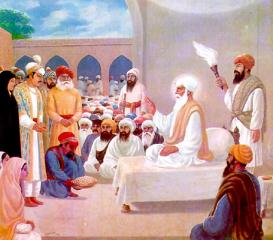Discover the life of Akali Kaur Singh, a revered Sikh scholar and preacher who championed education and social reform in India and Kashmir.
Explore the spiritual journey of Sadharan Path, a flexible reading of the Guru Granth Sahib, perfect for personal growth or special occasions.
Explore the rich history and cultural importance of the turban in Middle Eastern and South Asian societies. Unveil its religious and symbolic roles.
CHIEF KHALSA DIWAN. Until the emergence of more radical platforms such as the Sikh League (1919), Shiromam Gurdwara Parbandhak Committee (1920) and Shiromani Akali Dal (1920), the Chief Khalsa Diwan, established on 30 October 1902, was the main council of the Sikhs, controlling their religious and educational affairs and raising its voice in behalf of their political rights. It has proved to be a durable setup and it still retains its initiative in education, though its role in the other spheres has progressively shrunken over the years.
Discover Khalsa Diwan Majha's pivotal role in social and religious reform among Sikhs since 1904, advocating for simplified marriages and sobriety.
Explore the spiritual essence of sangat, the fellowship vital for Sikh community life, fostering selfless service and spiritual growth through shared devotion.
Explore Pandit Varyam Singh's legacy as a revered religious scholar and education advocate in Punjab. Discover his influence in Sikh reform.
DEV SAMAJ, a religious and social reform society, was founded on 16 February 1887 in Lahore by Pandit Shiv Narayan Agnihotri (1850-1929). The story of the Dev Samaj is in essence the story of its founder. Pandit Agnihotri was born in the village of Akbarpur, in Uttar Pradesh, on 20 December 1850. At sixteen he went to Thomson College of Engineering at Roorkee. In November 1873, he moved to Lahore taking a position as drawing master at the Government College.
Explore Khalsa Diwan Malaya, promoting Sikhism and education in Malaysia since 1903. Discover its impact on Sikh temples and cultural growth.
Discover the spiritual journey of Saptahik Path, a week-long reading of the Guru Granth Sahib, engaging both individuals and groups in a profound Sikh tradition.




